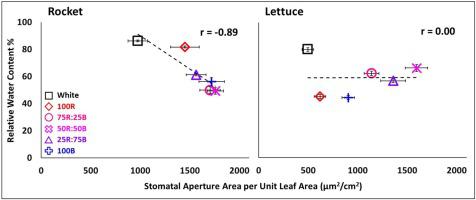当前位置:
X-MOL 学术
›
Environ. Exp. Bot.
›
论文详情
Our official English website, www.x-mol.net, welcomes your
feedback! (Note: you will need to create a separate account there.)
LED pre-exposure shines a new light on drought tolerance complexity in lettuce (Lactuca sativa) and rocket (Eruca sativa)
Environmental and Experimental Botany ( IF 4.5 ) Pub Date : 2020-12-01 , DOI: 10.1016/j.envexpbot.2020.104240 Daniel N. Ginzburg , Joshua D. Klein
Environmental and Experimental Botany ( IF 4.5 ) Pub Date : 2020-12-01 , DOI: 10.1016/j.envexpbot.2020.104240 Daniel N. Ginzburg , Joshua D. Klein

|
Abstract We investigated the morphological and physiological bases of drought tolerance in rocket (Eruca sativa) and lettuce (Lactuca sativa) seedlings as induced by pre-exposure to different ratios of red (R) and blue (B) LED light. Seedlings were grown for 17–18 days under white (control), 100R:0B, 75R:25B, 50R:50B, 25R:75B, or 0R:100B LED lighting at 156 μmol/m2/s. All seedlings were moved under white fluorescent lights 17–18 days after sowing. Half the seedlings were then droughted for 7 days, followed by re-irrigation for 7 days, while the other seedlings remained fully irrigated. Exposure to combined red and blue wavelengths promoted morphological development (leaf area, number of open leaves, leaf specific weight), as well as pigment (chlorophyll, carotenoids) and secondary metabolite (flavonoid) biosynthesis in both species. Morphological and physiological characteristics were more enhanced by monochromatic red or blue light exposure in lettuce than in rocket. Rocket grown under combined R:B lighting, and lettuce grown under 100 % red or blue LED light suffered most from drought (in the form of lower relative water content (RWC) and increased membrane leakage), despite increased ABA concentrations and antioxidant activity at mid-drought. In lettuce, but not in rocket, there was a positive residual effect of LED pre-treatment on fresh weight of droughted and re-irrigated plants. Increased concentrations of antioxidant metabolites did not correlate with tolerance to drought. All combined R:B light treatments increased stomatal density in both rocket and lettuce. All LED regimes which resulted in increased stomatal aperture area per unit leaf area (AALA) (μm2 aperture/cm2 leaf) resulted in decreased RWC at the end of drought. Stomatal AALA was negatively correlated with end-drought RWC (r = -0.89, p = 0.02) in rocket, but not in lettuce. The relationship between stomatal development and antioxidant activity on drought tolerance appears to be species-specific. The benefits provided to two leafy green species when grown under LED lights must be balanced against the resulting vulnerability to drought.
中文翻译:

LED 预曝光为莴苣 (Lactuca sativa) 和火箭 (Eruca sativa) 的耐旱复杂性提供了新的视角
摘要 我们研究了预先暴露于不同比例的红 (R) 和蓝 (B) LED 灯诱导的火箭 (Eruca sativa) 和生菜 (Lactuca sativa) 幼苗耐旱的形态和生理基础。幼苗在白色(对照)、100R:0B、75R:25B、50R:50B、25R:75B 或 0R:100B LED 照明下以 156 μmol/m2/s 生长 17-18 天。播种后 17-18 天将所有幼苗移至白色荧光灯下。然后将一半的幼苗干旱 7 天,然后重新灌溉 7 天,而其他幼苗则保持充分灌溉。暴露于组合的红色和蓝色波长促进了两种物种的形态发育(叶面积、开放叶数、叶比重)以及色素(叶绿素、类胡萝卜素)和次生代谢物(类黄酮)的生物合成。与火箭相比,生菜中的单色红光或蓝光暴露更能增强形态和生理特征。在组合 R:B 照明下生长的火箭和在 100% 红色或蓝色 LED 灯下生长的生菜最受干旱影响(以较低的相对含水量 (RWC) 和膜渗漏增加的形式),尽管 ABA 浓度和抗氧化活性在中旱。在生菜中,而不是在火箭中,LED 预处理对干旱和重新灌溉植物的鲜重有积极的残余影响。抗氧化代谢物浓度的增加与耐旱性无关。所有组合的 R:B 光处理都增加了火箭弹和生菜的气孔密度。所有导致每单位叶面积气孔面积 (AALA) (μm2 孔径/cm2 叶) 增加的 LED 方案导致干旱结束时 RWC 降低。在火箭中气孔 AALA 与干旱末期 RWC (r = -0.89, p = 0.02) 呈负相关,但在生菜中则不然。气孔发育与抗旱性抗氧化活性之间的关系似乎具有物种特异性。在 LED 灯下生长的两种绿叶植物所带来的好处必须与由此产生的干旱脆弱性相平衡。
更新日期:2020-12-01
中文翻译:

LED 预曝光为莴苣 (Lactuca sativa) 和火箭 (Eruca sativa) 的耐旱复杂性提供了新的视角
摘要 我们研究了预先暴露于不同比例的红 (R) 和蓝 (B) LED 灯诱导的火箭 (Eruca sativa) 和生菜 (Lactuca sativa) 幼苗耐旱的形态和生理基础。幼苗在白色(对照)、100R:0B、75R:25B、50R:50B、25R:75B 或 0R:100B LED 照明下以 156 μmol/m2/s 生长 17-18 天。播种后 17-18 天将所有幼苗移至白色荧光灯下。然后将一半的幼苗干旱 7 天,然后重新灌溉 7 天,而其他幼苗则保持充分灌溉。暴露于组合的红色和蓝色波长促进了两种物种的形态发育(叶面积、开放叶数、叶比重)以及色素(叶绿素、类胡萝卜素)和次生代谢物(类黄酮)的生物合成。与火箭相比,生菜中的单色红光或蓝光暴露更能增强形态和生理特征。在组合 R:B 照明下生长的火箭和在 100% 红色或蓝色 LED 灯下生长的生菜最受干旱影响(以较低的相对含水量 (RWC) 和膜渗漏增加的形式),尽管 ABA 浓度和抗氧化活性在中旱。在生菜中,而不是在火箭中,LED 预处理对干旱和重新灌溉植物的鲜重有积极的残余影响。抗氧化代谢物浓度的增加与耐旱性无关。所有组合的 R:B 光处理都增加了火箭弹和生菜的气孔密度。所有导致每单位叶面积气孔面积 (AALA) (μm2 孔径/cm2 叶) 增加的 LED 方案导致干旱结束时 RWC 降低。在火箭中气孔 AALA 与干旱末期 RWC (r = -0.89, p = 0.02) 呈负相关,但在生菜中则不然。气孔发育与抗旱性抗氧化活性之间的关系似乎具有物种特异性。在 LED 灯下生长的两种绿叶植物所带来的好处必须与由此产生的干旱脆弱性相平衡。











































 京公网安备 11010802027423号
京公网安备 11010802027423号